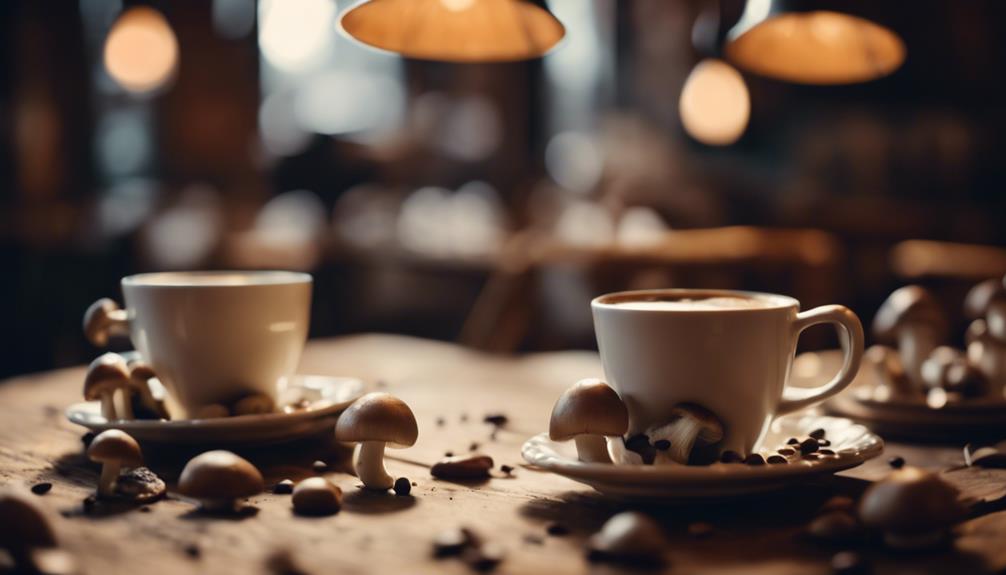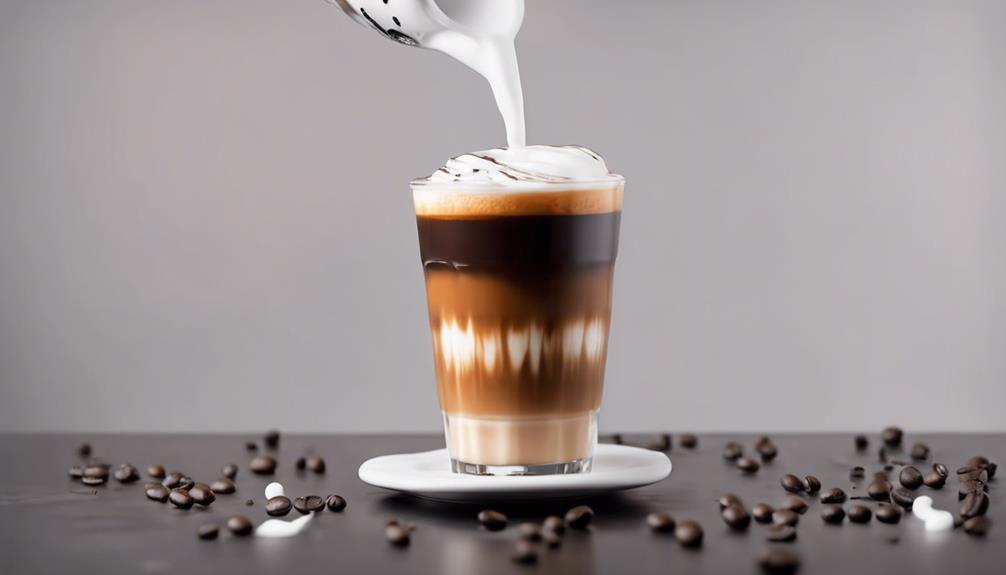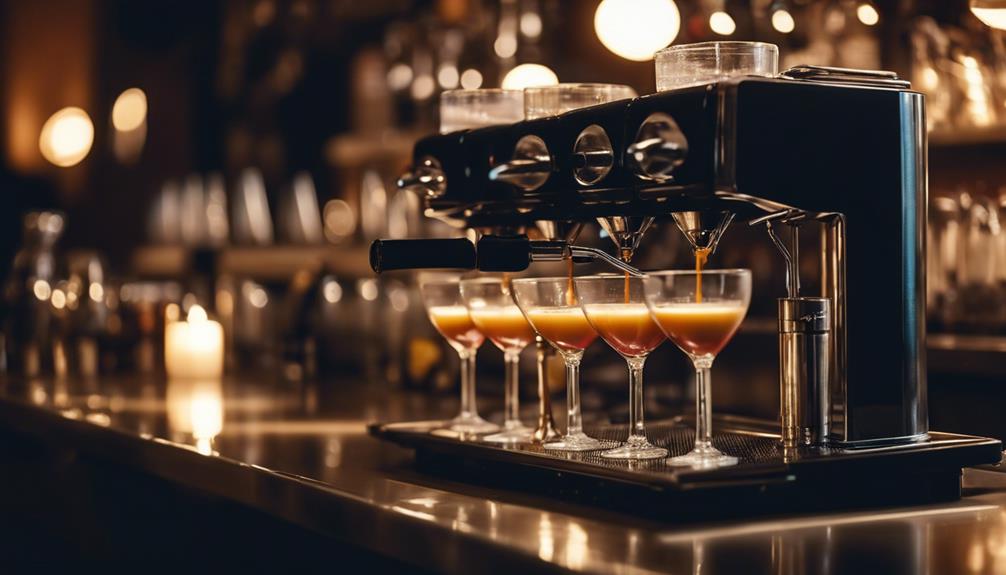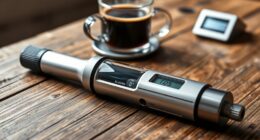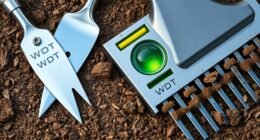You’re probably fed up with dealing with the mess and clutter that comes with making espresso, and that’s where an espresso knock box comes in – a necessary tool designed to keep your counter clean, tidy, and organized. Top-rated options such as the homeffect Knock Box and Crema Coffee Products The Arc offer stylish designs, durability, and easy cleaning features to simplify your cleanup routine. By considering key features like material durability, design, and aesthetic appeal, you can find the ideal knock box to meet your needs. Delve deeper to explore the world of espresso knock boxes and learn how to enhance your coffee-making experience.
Key Takeaways
- Consider a knock box with a large capacity to reduce emptying frequency and keep your counter tidy.
- Look for models with removable bars and wide openings for easy cleaning and maintenance.
- A non-slip base and ergonomic design ensure stability and minimize splashing during use.
- Empty your knock box every few days to prevent moisture buildup and mold growth.
Top-Rated Espresso Knock Boxes
When it comes to finding the perfect espresso knock box for your daily grind, several top-rated options stand out from the crowd, each offering unique features and benefits that cater to different needs and preferences.
You might contemplate the homeffect Knock Box, praised as the best overall, which boasts a unique vertical knock-pad design for enhanced stability while being lightweight and easy to clean in the dishwasher, all for just $20.
If aesthetics are important to you, the Crema Coffee Products The Arc is a stylish choice, featuring a tapered body and walnut lid, with a removable knock bar for convenience, priced at $55.
For a compact option that fits on most espresso machine drip trays, the Dreamfarm Grindenstøin is a great choice, equipped with a thick rubber bar for shock absorption, available for $25.
You may also want to contemplate the Rattleware Bumper Knock Box for heavy-duty use, offering a commercial-grade design with an offset knock bar for cleaner puck release, retailing at $60.
Testing and Evaluation Criteria
As you evaluate espresso knock boxes, it's crucial to take into account the testing methodology and criteria used to assess their performance.
You'll want to look at how they're tested for usability, cleaning efficiency, and other key factors that impact your daily coffee-making routine.
Espresso Knock Box Testing
You evaluated the espresso knock boxes based on three key criteria: usability, design, and cleaning efficiency, to guarantee they meet your practical needs in a coffee brewing environment.
To put these boxes to the test, you conducted over 100 shots of espresso using standardized tests for puck release and sturdiness. The Standard Puck Knock Test and Baked-In Puck Knock Test helped you assess the knock boxes' performance.
You found that models with off-center bars, like the knock drawer with a removable knock bar, improved puck drop accuracy and reduced mess. Wider openings made cleanup a breeze, and thick padding contributed to enhanced comfort and stability during use, reducing vibration transfer.
The test results informed your ranking of each knock box, highlighting user-friendly features and the importance of easy maintenance for everyday use.
Criteria for Evaluation
Evaluating the perfect espresso knock box requires a thorough understanding of the testing and evaluation criteria, which in this case included usability, design, and cleaning efficiency.
You'll want to contemplate how easy the knock box is to use, its overall design, and how efficiently it can be cleaned. When testing, you'll want to put the knock box through its paces, running over 100 shots of espresso to assess its performance. Tests like the Standard Puck Knock Test and Usability and Clean-Up Tests will give you a good idea of how well the knock box performs.
Look for features that make the knock box easy to clean, such as removable bars and a wide opening for improved aiming and cleanup.
You'll also want to contemplate the design of the knock box, with off-center bars improving puck drop accuracy and thick padding enhancing stability and comfort during use.
By evaluating these criteria, you'll be able to find an espresso knock box that meets your needs and keeps your counter clean and tidy. One important criteria to consider is the size of the knock box, as it should fit comfortably on your countertop without taking up too much space. Additionally, the material of the knock box is important as it should be durable and easy to clean. Another factor to consider is the design of the knock box, as it should complement the aesthetic of your home or stacks espresso bar. Overall, carefully evaluating these criteria will ensure that you find the perfect espresso knock box for your needs.
Key Features to Consider

When choosing an espresso knock box, you'll want to reflect on several key features that'll impact your overall experience.
You're looking for a knock box that's both functional and durable, so think about the material it's made of and the design features that'll make your life easier.
Material Durability
As you shop for an espresso knock box, the material's durability is an essential aspect to take into account, as it directly impacts the product's lifespan and overall performance.
You'll want to look for materials that can withstand repeated impacts during use, such as stainless steel, which is commonly used in espresso knock boxes. This durable material guarantees long-lasting performance and can handle a large capacity of espresso pucks.
Some high-end models even use high-quality 45 Steel, offering both sturdiness and resistance to corrosion, making them ideal for frequent espresso brewing.
Additionally, silicone-wrapped aluminum rods in knock bars provide a noise-reducing feature while protecting the coffee handle from damage during puck ejection.
Regular maintenance and cleaning of these durable materials, especially stainless steel, are vital to prevent buildup and maintain their aesthetic appeal over time.
Design Aesthetics
You'll also want to contemplate the design aesthetics of your espresso knock box, which can greatly impact your overall brewing experience and kitchen decor. As a coffee enthusiast, you'll appreciate a coffee accessory that not only serves a practical purpose but also elevates your kitchen's style.
Look for designs that feature non-slip bases, which guarantee stability and protect your countertops from scratches. A removable knock bar is also a must-have, making cleaning and maintenance a breeze.
Consider the capacity of the knock box, with larger models accommodating more pucks and reducing the frequency of emptying. Unique design elements, such as curved bevel designs, can minimize splashing and enhance the user experience.
Aesthetically pleasing options, like the Crema Coffee Products The Arc with a walnut lid, can add a touch of sophistication to your kitchen. By considering these design aesthetics, you'll find an espresso knock box that not only keeps your counter clean and tidy but also complements your kitchen's style.
Design and Material Quality
Designers of espresso knock boxes prioritize durability and functionality by selecting high-quality materials that can withstand the rigors of frequent use. You'll notice that many knock boxes are made from stainless steel, high-quality rubber, and other durable materials that can handle repeated impacts from knocking coffee pucks. The homeffect Knock Box, for instance, features a unique vertical knock-pad design made of plastic, rubber, and stainless steel, guaranteeing stability and ease of cleaning.
When it comes to design, manufacturers are also focusing on aesthetics. The Crema Coffee Products The Arc, for example, showcases a stylish tapered body with a walnut lid, combining aesthetic appeal with functionality while being dishwasher-safe (excluding the wooden lid).
Some knock boxes, like the Rattleware Bumper Knock Box, utilize commercial-grade materials to enhance durability, with an offset knock bar for cleaner puck release. Meanwhile, models like the Dreamfarm Grindenstøin incorporate thick rubber bars to absorb shock and provide a non-slip surface, reducing vibration transfer during use.
Capacity and Storage Options
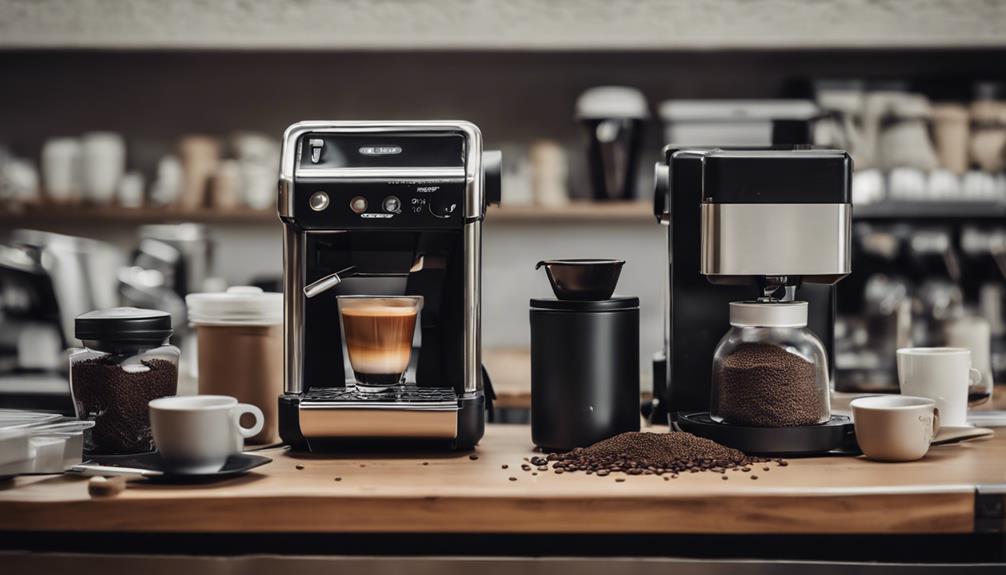
When selecting an espresso knock box, evaluate the capacity and storage options that fit your daily coffee needs, as a larger or smaller size can markedly impact your workflow and counter space.
You'll want to think about how often you brew espresso and how much space you have available on your counter. If you're a heavy user, a larger capacity knock box like the Rattleware Bumper Knock Box might be ideal, as it can hold more pucks and reduce the need for frequent emptying.
On the other hand, if you're a casual coffee lover, a smaller capacity option like the Ompellus knock box might be more suitable, storing up to 23 coffee grounds. Compact designs like the Dreamfarm Grindenstøin are perfect for smaller espresso machines, fitting neatly on the drip tray while still providing ample storage.
Don't forget to evaluate the size of your espresso portafilter when choosing a knock box, ensuring a seamless workflow.
Maintenance and Cleaning Tips
To keep your espresso knock box in top condition, it's vital to establish a regular cleaning routine to prevent the buildup of old coffee grounds and moisture. You should empty your knock box every few days and perform a full cleaning after grounds removal. This will prevent moisture buildup and mold growth.
| Cleaning Tips | Why It Matters |
|---|---|
| Empty knock box every few days | Prevents moisture buildup and mold growth |
| Wipe down stainless steel surfaces | Maintains cleanliness and prevents rust |
| Hand-wash wooden components | Guarantees durability and longevity |
| Clean rubber bases regularly | Prevents slipping and guarantees easy cleanup |
| Establish a regular cleaning schedule | Prevents buildup of used coffee grounds and guarantees longevity |
User Experience and Feedback
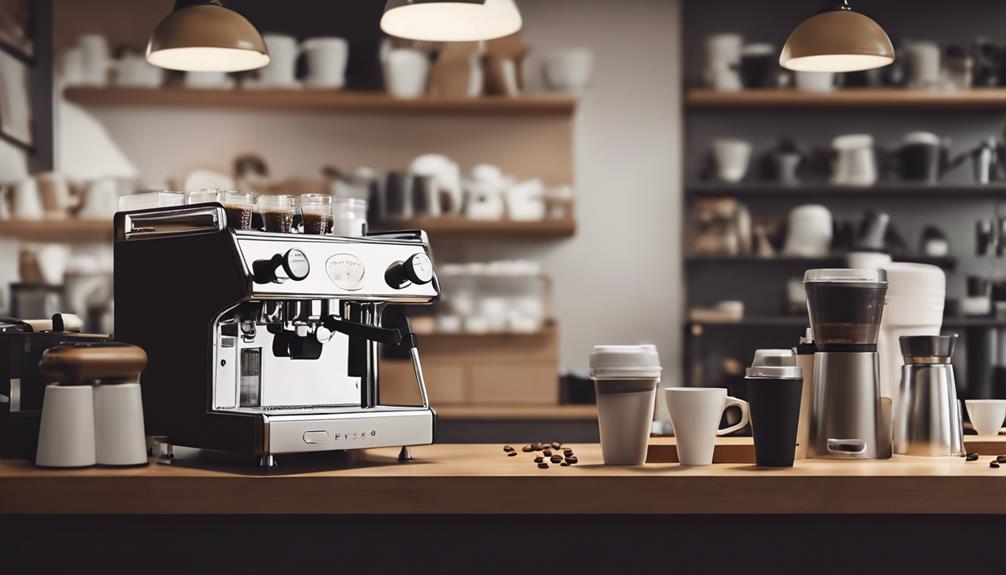
Users consistently rave about the Ompellus Espresso Knock Box's overall performance, praising its sturdy design, large capacity, and cleverly thought-out features that make it a joy to use.
You'll appreciate the high-quality materials and clever design elements that make your espresso-making experience a breeze.
Here are just a few reasons why users love this knock box:
- Effortless use: The ergonomic arc bevel design guarantees smooth knocking with minimal splashing, making it easy to use for both baristas and coffee enthusiasts.
- Low maintenance: You can easily disassemble the knock box for cleaning by loosening a few screws, making maintenance a breeze.
- Space-saving design: The large capacity of the knock box means you can hold up to 23 coffee grounds, reducing the frequency of emptying and saving you valuable counter space.
- Durable construction: The silicone-wrapped aluminum knock bar is designed to minimize noise and protect your coffee handles, guaranteeing your knock box lasts for years to come.
With its removable bar and easy-to-clean design, the Ompellus Espresso Knock Box is the perfect addition to your coffee-making setup.
Frequently Asked Questions
What Is the Point of an Espresso Knock Box?
You wonder, what's the point of an espresso knock box? It's actually a game-changer! You'll save time and space by efficiently storing used coffee grounds, keeping your counter clean, and streamlining your espresso-making process.
How to Clean a Knockbox?
You'll want to clean your knock box regularly, disassembling it for easier maintenance. Wipe down stainless steel surfaces with a damp cloth, rinse rubber bases under warm water, and hand-wash wooden parts to keep it hygienic.
How to Stop Mould in Coffee Knock Box?
You stop mould in your coffee knock box by emptying it every few days, washing it with soapy water, and storing it in a dry area; regular inspections also help detect and prevent mould growth.
Do Coffee Knock Boxes Smell?
You'll notice that your coffee knock box can smell if you don't clean it regularly, as leftover grounds retain moisture, leading to mold or mildew growth, which can be prevented with frequent emptying and thorough cleaning.
Conclusion
As you savor the perfect shot, your espresso knock box stands sentinel, a stainless steel guardian of your counter's sanity.
With every discarded puck, it silently serves, keeping your workspace tidy and your focus on the art of brewing.
In this harmony of form and function, your espresso ritual becomes a symphony of precision, with the knock box as the unsung hero, quietly keeping your creative space clutter-free and your coffee game strong.

